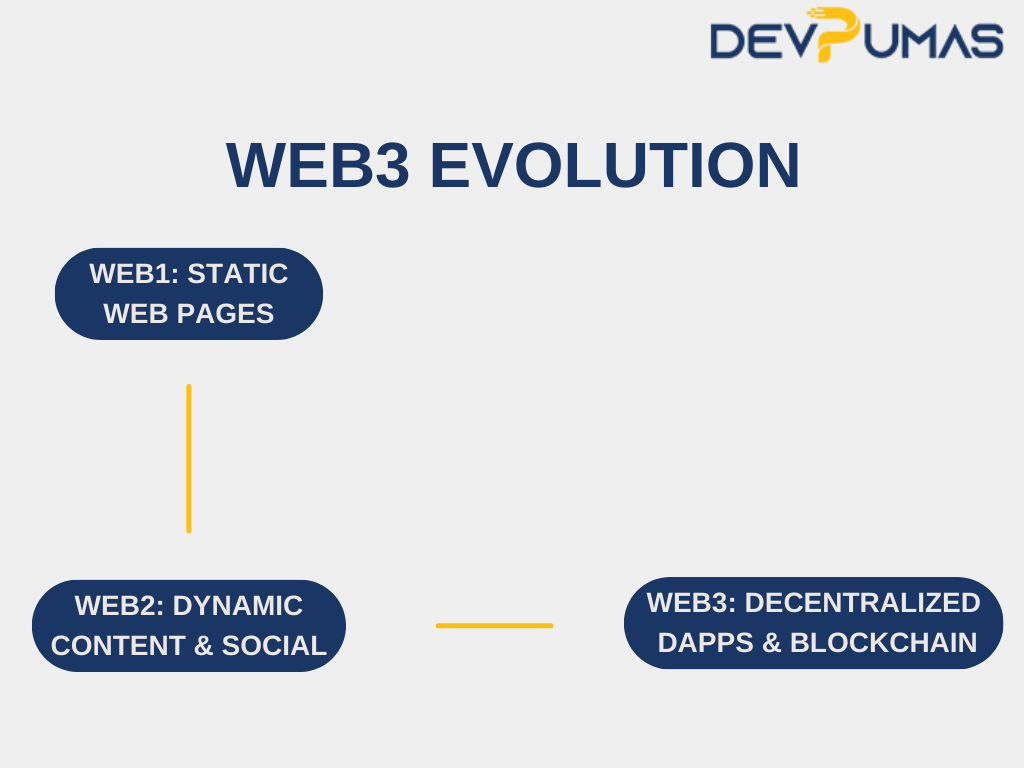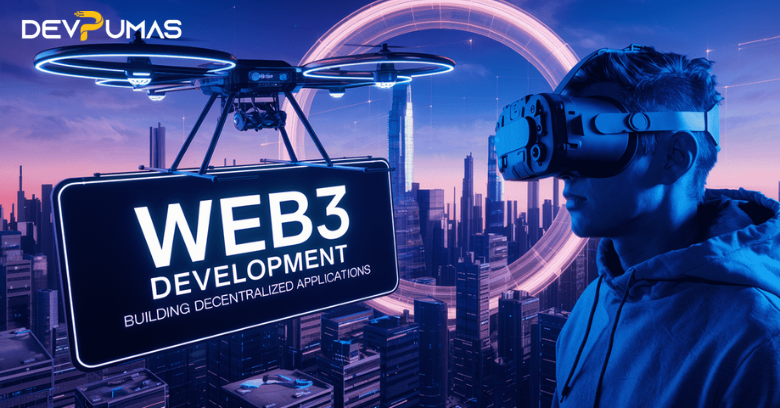Introduction
The internet is evolving, and with this evolution comes the rise of Web3, a decentralized version of the web that promises to reshape the way we interact online. Unlike the current Web2 model, which relies heavily on centralized servers and intermediaries, Web3 is built on blockchain technology, enabling decentralized applications (dApps) that are more secure, transparent, and user-centric. For developers, Web3 development opens up a new frontier of possibilities, allowing them to create applications that are not only innovative but also have the potential to disrupt traditional industries. In this article, we’ll explore the fundamentals of Web3, the key components of dApps, and how developers can get started with Web3 development.
What is Web3?
Web3, often referred to as the decentralized web, represents the third generation of internet services and applications. While Web1 was characterized by static websites and Web2 introduced dynamic content and social media, Web3 is all about decentralization, blockchain, and peer-to-peer networks. The goal of Web3 is to give users control over their data, remove the need for intermediaries, and enable secure, trustless transactions.
Key Characteristics of Web3:
- Decentralization: Unlike Web2, where data is stored on centralized servers, Web3 applications (dApps) store data on decentralized networks using blockchain technology. This reduces the risk of data breaches and censorship.
- Ownership: In Web3, users have ownership of their data and digital assets. They can interact directly with applications without relying on third parties.
- Interoperability: Web3 applications are designed to work seamlessly with each other, allowing for greater collaboration and innovation across the ecosystem.

The Fundamentals of Web3 Development
Before diving into Web3 development, it’s important to understand the key components that make up this new ecosystem. These components include blockchain technology, smart contracts, decentralized applications (dApps), and the tools and frameworks that developers use to build them.
1. Blockchain Technology
At the core of Web3 is blockchain technology, a distributed ledger that records transactions across a network of computers. Each block in the blockchain contains a list of transactions, and once a block is added to the chain, it cannot be altered. This immutability makes blockchain an ideal foundation for secure and transparent applications.
Popular Blockchains for Web3 Development:
- Ethereum: The most widely used blockchain for dApp development, Ethereum supports smart contracts and has a robust developer ecosystem.
- Binance Smart Chain (BSC): A blockchain that offers faster transactions and lower fees, making it an attractive option for dApp developers.
- Polkadot: Known for its interoperability, Polkadot allows different blockchains to communicate and share information.
2. Smart Contracts
Smart contracts are self-executing contracts with the terms of the agreement directly written into code. They run on the blockchain and automatically enforce the terms of the contract when certain conditions are met. Smart contracts are the backbone of Web3 development, enabling decentralized applications to operate without the need for intermediaries.
Example Use Case: A smart contract on Ethereum could be used to facilitate a peer-to-peer loan, where the terms are automatically enforced, and funds are released only when all conditions are met.
3. Decentralized Applications (dApps)
Decentralized applications, or dApps, are applications that run on a blockchain network rather than on centralized servers. dApps leverage smart contracts to perform various functions, from financial transactions to governance and beyond. They are open-source, transparent, and typically incentivize users through tokens.
Key Features of dApps:
- Decentralization: dApps operate on a peer-to-peer network, eliminating the need for a central authority.
- Transparency: All transactions and activities within a dApp are recorded on the blockchain, making them transparent and auditable.
- Incentivization: Many dApps have built-in token economies that reward users for participating in the network.
Getting Started with Web3 Development
Now that we’ve covered the basics of Web3 and its key components, let’s explore how developers can start building decentralized applications. Web3 development requires a different mindset and set of tools compared to traditional web development, but the potential rewards are immense.
1. Learn the Basics of Blockchain and Smart Contracts
Before you can start building dApps, it’s essential to have a solid understanding of blockchain technology and how smart contracts work. Many online resources, courses, and tutorials can help you get started.
Recommended Resources:
- Coursera: Courses on blockchain fundamentals and smart contract development.
- Solidity Documentation: The official documentation for Solidity, the most widely used programming language for writing smart contracts on Ethereum.
- CryptoZombies: An interactive tutorial that teaches you Solidity by building a simple game on Ethereum.
2. Choose a Blockchain Platform
The next step in Web3 development is choosing the blockchain platform on which to build your dApp. Ethereum is the most popular choice due to its large developer community and extensive documentation. However, other platforms like Binance Smart Chain and Polkadot also offer unique advantages.
Factors to Consider:
- Transaction Fees: Ethereum is known for its high gas fees, so if cost is a concern, you might want to explore alternatives like Binance Smart Chain.
- Scalability: Consider how well the blockchain can scale with your application’s needs. Some blockchains, like Polkadot, offer enhanced scalability through their unique architectures.
- Developer Tools: Look for a platform with robust developer tools, including IDEs, debuggers, and libraries, to streamline the development process.
3. Set Up Your Development Environment
Once you’ve chosen your blockchain platform, it’s time to set up your development environment. This typically involves installing the necessary tools and libraries to write and deploy smart contracts, as well as interact with the blockchain.
Essential Tools for Web3 Development:
- Truffle: A development framework for Ethereum that makes it easier to write, test, and deploy smart contracts.
- Remix: An online IDE for writing Solidity contracts and deploying them to the Ethereum blockchain.
- Web3.js: A JavaScript library that allows developers to interact with the Ethereum blockchain from a web application.
4. Write and Deploy Smart Contracts
Smart contracts are the backbone of any dApp, so writing and deploying them is a critical step in Web3 development. Solidity is the most common language for writing Ethereum smart contracts, but other blockchains may use different languages (e.g., Rust for Solana).
Steps to Deploy a Smart Contract:
- Write the Contract: Use Solidity to write the smart contract. The contract should include all the logic and rules for your dApp.
- Compile the Contract: Use the Solidity compiler (solc) to compile your contract into bytecode that can be executed on the Ethereum Virtual Machine (EVM).
- Deploy the Contract: Deploy the compiled contract to the blockchain using tools like Truffle or Remix.
5. Build the Frontend for Your dApp
The frontend of a dApp is similar to traditional web applications but with some key differences. The frontend will interact with the blockchain via smart contracts, and this interaction is typically handled using Web3.js or similar libraries.
Frontend Development Considerations:
- User Interface (UI): The UI should be intuitive and user-friendly, especially since many users may be new to blockchain technology.
- Blockchain Interaction: Use Web3.js to connect the frontend to the blockchain and interact with your deployed smart contracts.
- Wallet Integration: Integrate with crypto wallets like MetaMask to enable users to interact with your dApp, such as making transactions or voting in governance proposals.
Example Use Case: A decentralized marketplace dApp could allow users to list items for sale, make purchases using cryptocurrency, and track ownership through smart contracts.
Challenges in Web3 Development
While Web3 development offers exciting opportunities, it also comes with its own set of challenges. Developers need to be aware of these challenges to successfully navigate the Web3 landscape.
1. Security Concerns
Smart contracts are immutable once deployed, meaning any bugs or vulnerabilities cannot be easily fixed. This makes security a top priority in Web3 development. Developers must rigorously test their contracts and consider using formal verification methods to ensure correctness.
2. Scalability Issues
Blockchain networks can experience scalability issues, especially when dealing with high transaction volumes. Developers need to design their dApps with scalability in mind, potentially using Layer 2 solutions or alternative blockchains that offer better scalability.
3. User Experience (UX)
Many users are still unfamiliar with blockchain technology, so providing a seamless and intuitive user experience is crucial. This includes simplifying wallet integration, transaction management, and other blockchain interactions.
The Future of Web3 Development
The future of Web3 development is bright, with growing interest from developers, investors, and users alike. As blockchain technology continues to evolve, we can expect to see even more innovative dApps that challenge the status quo and offer new ways to interact online.
1. Cross-Chain Interoperability
Interoperability between different blockchains will be a key focus in the coming years. Projects like Polkadot and Cosmos are already working on solutions that allow different blockchains to communicate and share data seamlessly, paving the way for more complex and powerful dApps.
2. Decentralized Finance (DeFi)
Decentralized finance, or DeFi, is one of the fastest-growing areas in Web3. Developers who focus on DeFi have the opportunity to build applications that offer financial services like lending, borrowing, and trading without intermediaries, democratizing access to financial services.
3. Decentralized Autonomous Organizations (DAOs)
DAOs are another exciting area of Web3 development. DAOs are organizations governed by smart contracts, allowing for decentralized decision-making and governance. Developers can build tools and platforms that enable users to create and manage DAOs, potentially transforming how organizations operate.
Closure
Web3 represents a new era of the internet, one that is decentralized, secure, and user-centric. For developers, Web3 development offers a unique opportunity to build applications that challenge traditional models and empower users. By understanding the fundamentals of blockchain technology, smart contracts, and dApps, developers can begin exploring this exciting new frontier.
As the Web3 ecosystem continues to grow, staying informed about the latest developments, tools, and best practices will be crucial for success. Whether you’re building the next decentralized finance platform or a revolutionary DAO, the skills and knowledge you gain in Web3 development will position you at the forefront of this rapidly evolving space.



